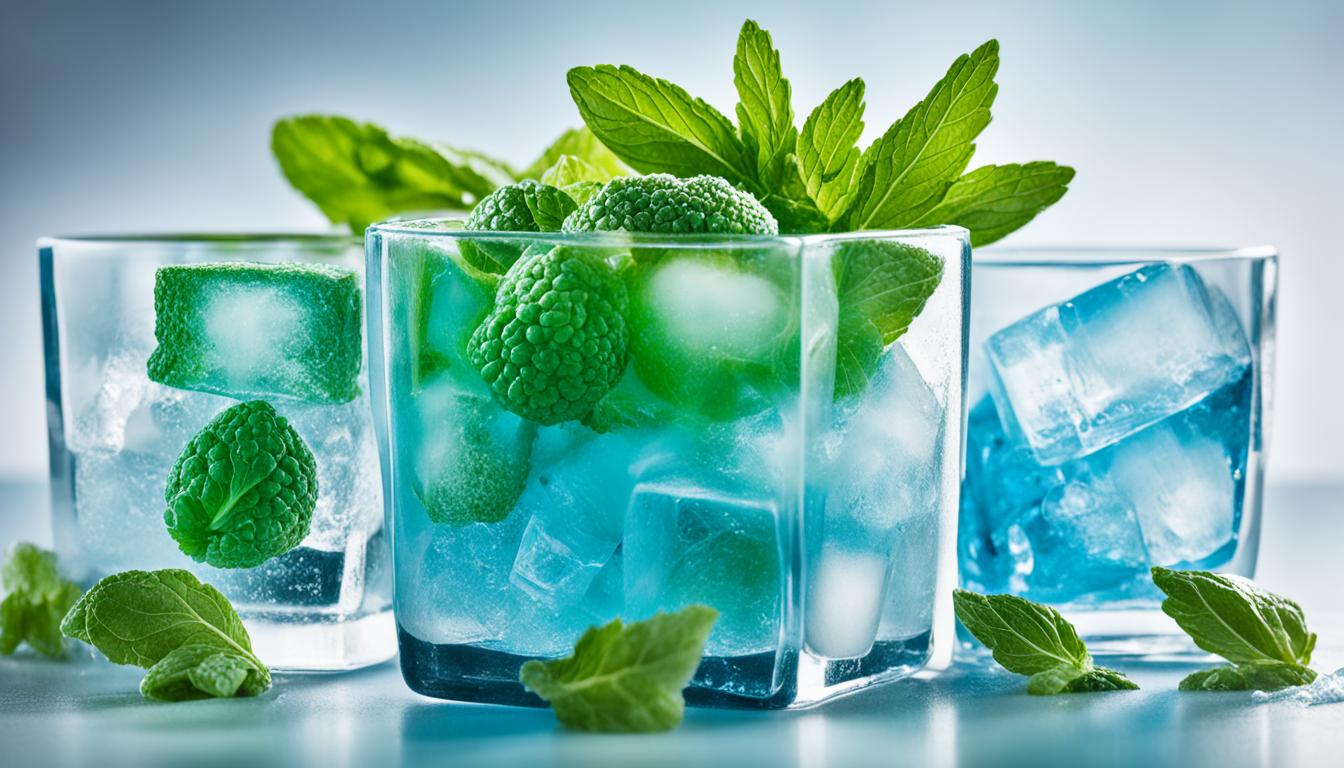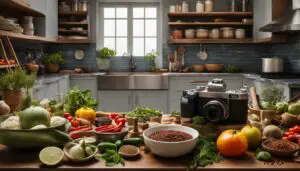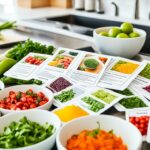Originally posted on March 26, 2024 @ 7:56 pm
Have you ever wondered what it means when a recipe says to “chill”? Does it mean refrigerate? Is there a specific temperature or time involved? Let’s dive into the world of chilling in cooking and unravel the mystery behind this common instruction.
Chilling is more than just a suggestion in recipes; it plays a crucial role in achieving the desired results. From food safety to enhancing flavors and textures, understanding the significance of chilling can take your cooking to the next level. So, let’s explore what chilling really means and why it is essential for your culinary success.
Contents
- 1 The Importance of Chilling in Recipes
- 2 Guidelines for Chilling Food in Recipes
- 3 Chilling Techniques and Tips
- 4 The Benefits of Chilling in Recipes
- 5 Common Recipes That Require Chilling
- 6 Chilling in Foodservice Industry
- 7 The Science Behind Chilling in Recipes
- 8 Tips for Successful Chilling in Recipes
- 9 Exploring Alternative Chilling Methods
- 10 Conclusion
- 11 FAQ
- 11.1 When a recipe says “chill,” what does it mean?
- 11.2 What is the difference between chilling and refrigerating in cooking?
- 11.3 How long do you need to chill food in recipes?
- 11.4 What are the benefits of chilling in recipes?
- 11.5 What are some common recipes that require chilling?
- 11.6 What is the importance of chilling in the foodservice industry?
- 11.7 What is the science behind chilling in recipes?
- 11.8 What are some tips for successful chilling in recipes?
- 11.9 Are there alternative chilling methods for food?
- 11.10 What is the conclusion about chilling in recipes?
- 12 Source Links
Key Takeaways:
- Chilling refers to the process of cooling food, typically in a refrigerator or freezer.
- Chilling is crucial for food safety, preventing bacterial growth and preserving ingredients.
- Chilling enhances flavors and textures, from flakier pastries to marinated salads.
- Proper chilling techniques, including time and temperature, are essential for recipe success.
- Alternative chilling methods, such as liquid nitrogen, offer unique effects but require caution.
The Importance of Chilling in Recipes
Chilling food is an essential step in many recipes, and its importance cannot be overstated. When a recipe instructs you to chill a dish, it serves multiple purposes that contribute to the overall success of the dish. Understanding why chilling is crucial in recipes can help you achieve better flavors, textures, and food safety in your cooking.
One significant reason for chilling food is to prevent bacterial growth. By cooling food to the proper temperature, you create an environment where bacteria cannot thrive. This is especially important for perishable ingredients like dairy products, eggs, and fresh meats. Proper chilling helps to ensure the safety of your food and reduce the risk of foodborne illnesses.
Furthermore, chilling can enhance the flavors and textures of certain dishes. For example, chilling dough before baking can result in flakier pastries, while chilling custards or mousses allows them to set and develop a creamy consistency. Additionally, chilling salads or desserts can help flavors meld together and create a more refreshing eating experience.
Chilling vs. Refrigerating: It’s important to note that chilling is different from refrigerating. While both processes involve cooling food, chilling refers to a specific cooling process carried out for a shorter duration. On the other hand, refrigerating refers to the overall storage of food at a low temperature, often for an extended period. Chilling is typically used in recipes to achieve specific outcomes, such as setting or enhancing flavors, while refrigerating is more about long-term preservation.
To further illustrate the difference between chilling and refrigerating, here’s a comparison:
| Chilling | Refrigerating |
|---|---|
| Involves a shorter duration | Involves a longer duration |
| Used to achieve specific outcomes (e.g., texture, flavors) | Primarily focuses on preservation |
| Often indicated in recipes | A general practice for long-term storage |
Understanding the importance of chilling in recipes can help you make informed decisions and follow recipe instructions accurately. By embracing this technique, you can enhance the quality of your dishes and ensure food safety.
Next, we’ll delve into guidelines for chilling food in recipes, including how long to chill different dishes and best practices for achieving optimal results.
Guidelines for Chilling Food in Recipes
The length of time you need to chill food in a recipe can vary depending on the specific dish. As a general rule, most recipes recommend chilling for at least a specific amount of time, such as 1-2 hours. However, certain recipes may require longer chilling times, especially for more complex or layered dishes. It’s important to follow the instructions provided in the recipe to ensure proper chilling and achieve the desired results.
In some cases, you may find recipes that specify a minimum chill time to guarantee the flavors meld together and achieve the desired consistency. For example, a recipe for a chilled soup may recommend chilling for a minimum of 4 hours to allow the flavors to develop and intensify. On the other hand, a simple fruit salad may only require a short chill time of 30 minutes to refresh and enhance the flavors.
When determining how long to chill food in a recipe, consider the ingredients and their texture. Some dishes, like custards or gelatin desserts, need sufficient time to set and become firm. Others, such as marinated meats or pickled vegetables, benefit from longer chilling times as it allows the flavors to infuse and develop. Layered desserts or cakes may require several hours to ensure the different components meld together into a cohesive and delicious treat.
It’s worth noting that chilling times can be flexible to some extent. If you find yourself pressed for time, you can often chill certain dishes for a shorter duration, but the final results may not be as optimal as following the recommended times. Likewise, if you have the luxury of extra time, extending the chilling period can further enhance the flavors and textures.
Ultimately, the key is to carefully read and understand the recipe instructions. The specific chill time will vary depending on the dish’s requirements, so trust the recipe’s guidance to achieve the best results. By following the guidelines for chilling food in recipes, you’ll ensure that your culinary creations are not only safe to consume but also deliver the desired taste and texture.
Chilling Techniques and Tips
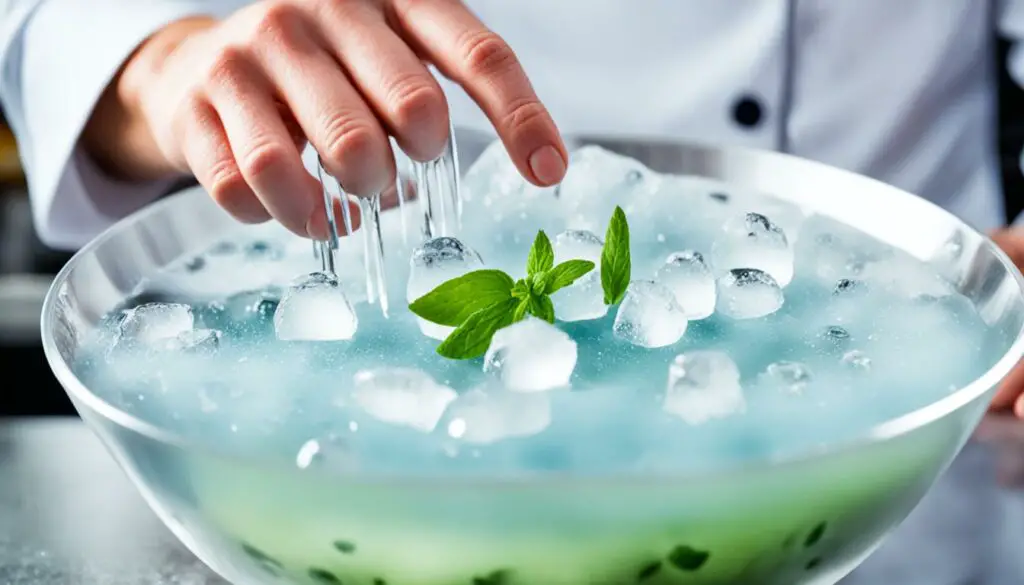
When it comes to chilling food in recipes, there are various techniques you can employ to achieve the desired results. Let’s explore some effective chilling techniques and important tips to ensure your dishes are properly cooled and preserved.
1. Refrigerator or Freezer Method
One common and straightforward method is to place the dish in the refrigerator or freezer. This technique allows for gradual cooling and ensures that the food reaches the desired temperature. Make sure to cover the dish properly, especially if it contains perishable ingredients, to prevent cross-contamination and maintain its quality and freshness.
2. Ice Bath
For hot liquids or soups that need to be cooled down quickly, an ice bath can be incredibly useful. Just place the pot or bowl of hot food in a larger bowl filled with ice and water. Stir the food occasionally to facilitate even cooling. This technique helps avoid overcooking and allows you to maintain the intended flavors and texture.
3. Proper Covering
Covering the food before chilling is crucial to prevent any flavors from being absorbed or transferred. It also prevents contamination from other ingredients in the refrigerator. Use plastic wrap, airtight containers, or aluminum foil to cover the dish securely and maintain its integrity and freshness.
4. Setting the Right Temperatures
Ensure that your refrigerator and freezer are set at the appropriate temperatures to maintain food safety. The ideal refrigerator temperature is below 40°F (4°C), while the freezer temperature should be 0°F (-18°C) or below. Regularly check and monitor the temperatures with a thermometer to ensure optimal food storage and preservation.
Now that we’ve explored these chilling techniques and tips, let’s have a look at how chilling in recipes offers numerous benefits and enhances the overall culinary experience.
| Chilling Techniques | Tips |
|---|---|
| Refrigerator or Freezer Method | Cover the dish properly to prevent cross-contamination and preserve quality. |
| Ice Bath | Place hot liquids in a bowl with ice and water to cool them down quickly. |
| Proper Covering | Use plastic wrap or airtight containers to prevent flavors from being absorbed. |
| Setting the Right Temperatures | Maintain refrigerator temperature below 40°F and freezer temperature below 0°F. |
The Benefits of Chilling in Recipes
Chilling food in recipes offers several benefits that contribute to the overall success of your culinary creations. Whether you’re making a refreshing salad, a delectable dessert, or a savory appetizer, chilling plays a crucial role in enhancing the taste, texture, and food safety of your dishes. Let’s take a closer look at the advantages of chilling in recipes.
Prolonged Shelf Life of Perishable Ingredients
Chilling helps to prolong the shelf life of perishable ingredients, allowing you to make the most of your fresh produce and minimize waste. By storing ingredients in the refrigerator or freezer, you can extend their freshness and usability, ensuring that you always have quality ingredients on hand for your recipes.
Enhanced Flavors and Textures
Chilling can enhance the flavors and textures of certain dishes, particularly desserts and salads. For example, chilling a creamy cheesecake can firm it up, resulting in a lusciously smooth and velvety texture. Similarly, chilling a salad can help the flavors marry and create a refreshing and well-balanced taste.
Improved Presentation and Settling
When it comes to dishes that need to set and hold their shape, chilling is key. By chilling foods like gelatin-based desserts or molded terrines, you can improve their presentation and ensure they maintain their desired form. Chilling also allows for the flavors and textures to settle and develop, resulting in a more cohesive and enjoyable eating experience.
Overall, the benefits of chilling in recipes go beyond mere food safety. It’s a technique that adds depth, longevity, and visual appeal to your culinary creations. By understanding the advantages of chilling, you can make more informed choices in your recipe execution and elevate your cooking game to new heights.
When it comes to chilling food in recipes, the benefits are palpable. From extending the shelf life of ingredients to enhancing flavors, textures, and presentation, chilling plays a vital role in achieving delicious and satisfying results in your cooking endeavors.
Common Recipes That Require Chilling
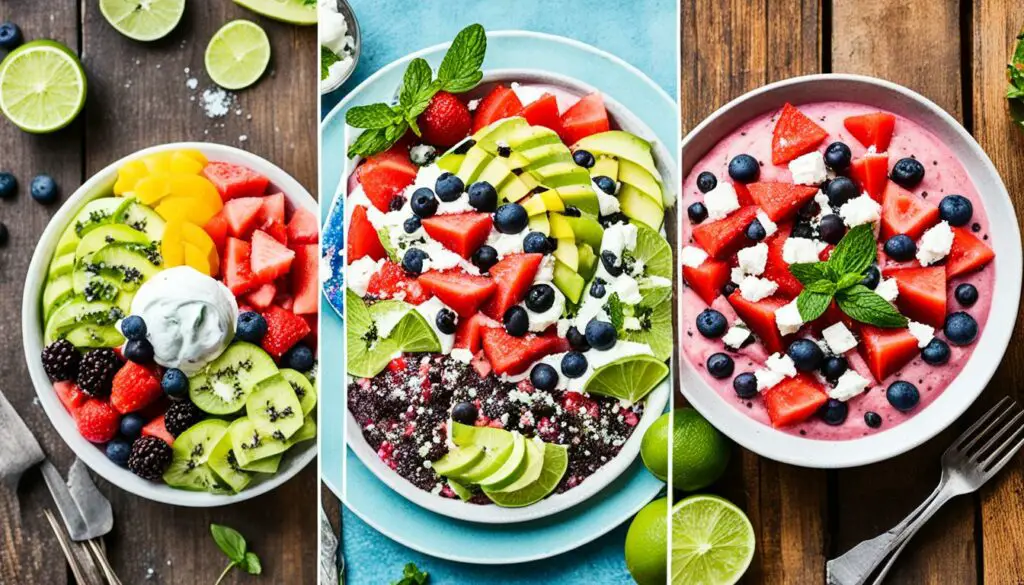
Chilling is a crucial step in many recipes, especially those that require specific textures or flavors. Here are some popular recipes that call for chilling:
No-Bake Cheesecake
One classic chilled dessert is the no-bake cheesecake. This creamy and indulgent treat sets perfectly when chilled in the refrigerator. Its velvety texture and rich flavors make it a crowd-pleaser for any occasion.
Mousse
Mousse is another delectable dessert that requires chilling. Whether it’s chocolate, fruit, or even savory mousse, chilling allows it to set and achieve a light, airy consistency that melts in your mouth.
Pasta Salad
Pasta salad, a popular side dish, benefits from chilling to allow the flavors to meld together. The dressing and ingredients, such as vegetables and herbs, infuse each other with their delicious flavors, creating a refreshing and vibrant dish.
Potato Salad
Similarly, potato salad is best enjoyed chilled. Chilling the cooked potatoes and other ingredients allows the flavors to blend, resulting in a harmonious combination of creamy, tangy, and savory tastes.
Pie Crust
To achieve a flaky and tender pie crust, chilling the dough is essential. This step helps solidify the fat in the dough, preventing it from melting too quickly during baking. The chilled dough ensures a beautifully crisp and golden crust.
Cookie Dough
When making cookies, chilling the dough is a secret to achieving the perfect texture. It helps control the spread of the cookies, resulting in a chewy interior and a crispy edge. Additionally, chilled cookie dough allows the flavors to develop and intensify.
These are just a few examples of popular recipes that require chilling. Whether you’re preparing a delightful dessert or a savory salad, taking the time to properly chill the dish can elevate its taste and presentation. So, embrace the chilling process and enjoy the delicious results!
Chilling in Foodservice Industry

Chilling plays a significant role in the foodservice industry, providing caterers with a controlled system of food preparation that ensures food quality, safety, and efficiency. One popular technique used in the industry is the Cook & Chill system, which involves cooking food, followed by rapid chilling and storage at controlled temperatures.
The benefits of implementing Cook & Chill systems in foodservice operations are numerous. They offer flexibility, management, and profitability, allowing caterers to streamline their processes and meet customer demands effectively. By using chill techniques, caterers can maintain the nutritional value, flavor, and appearance of their prepared foods.
One notable Cook & Chill system in the market is the BE-1 Cook & Chill system, which provides a comprehensive solution for food preparation and storage. This system adheres to food safety regulations and enables efficient production and regeneration of food for service.
“Implementing Cook & Chill systems in our foodservice operation has been a game-changer. It allows us to maintain consistent food quality, improve productivity, and reduce waste. Plus, our customers appreciate the freshness and taste of our chilled dishes.” – Chef Sarah Johnson, ABC Catering
Benefits of Cook & Chill Systems:
- Enhanced food quality and preservation
- Improved operational efficiency
- Reduced food waste
- Increased menu flexibility
- Consistent taste and flavor
- Compliance with food safety regulations
Implementing Cook & Chill systems in the foodservice industry offers numerous advantages and enables caterers to meet the demands of their customers effectively. It ensures that prepared food maintains its quality, nutritional value, flavor, and appearance, resulting in satisfied customers and successful foodservice operations.
The Science Behind Chilling in Recipes
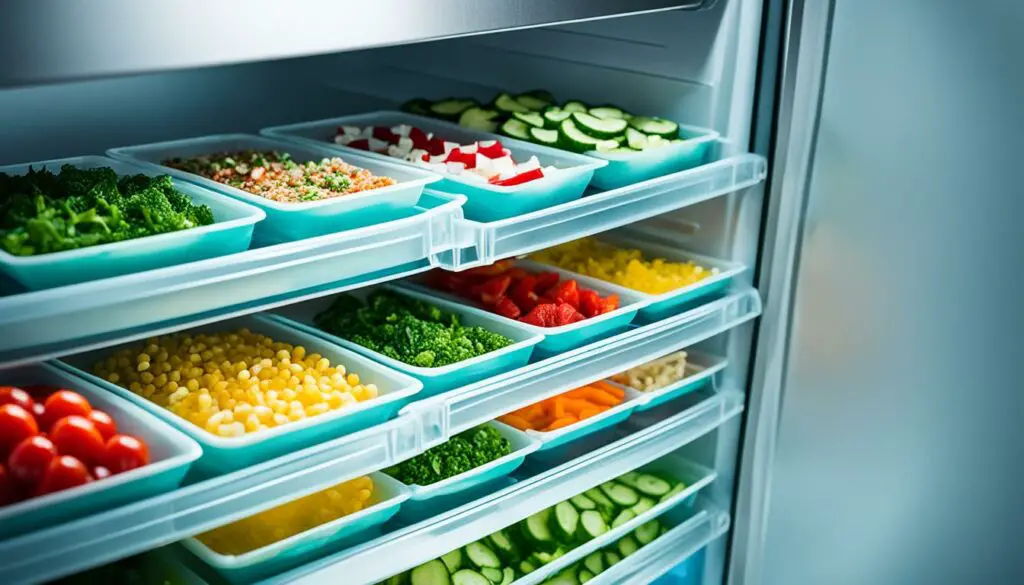
Chilling food in recipes is not just a random step; it is rooted in the science of food safety. Understanding the principles behind chilling can help you ensure the safety and quality of your culinary creations.
Bacteria thrive in temperatures between 5°C and 63°C, known as the hazard zone. This temperature range allows bacteria to multiply rapidly, increasing the risk of foodborne illnesses. By chilling food quickly and properly, you create an environment where bacterial growth is inhibited, reducing the likelihood of contamination.
Achieving rapid cooling can be accomplished by using blast chillers or blast freezers. These specialized appliances cool food at a fast rate, preventing bacterial growth and preserving the freshness and quality of the ingredients. It’s important to adhere to food safety regulations and guidelines to ensure optimal results.
“Proper chilling is crucial for maintaining food safety and preventing the growth of harmful bacteria.”
By employing the science of chilling, you can confidently prepare and store food, minimizing the risk of foodborne illnesses while maximizing the flavor and longevity of your dishes.
| Benefits of Proper Chilling Process | Consequences of Improper Chilling Process |
|---|---|
| Prevents bacterial growth and foodborne illnesses | Increases risk of contamination and food poisoning |
| Preserves freshness and quality of ingredients | Leads to spoiled or spoiled-tasting food |
| Extends shelf life of perishable ingredients | Shortens the lifespan of ingredients |
| Ensures food safety compliance | Violates food safety regulations |
Food Safety Guidelines for Proper Chilling:
- Use blast chillers or blast freezers for rapid cooling.
- Store food at the appropriate temperature to inhibit bacterial growth.
- Follow food safety regulations and guidelines to ensure compliance.
- Cover and wrap food properly to prevent cross-contamination.
- Regularly monitor and maintain refrigerator and freezer temperatures.
Understanding the science behind chilling in recipes empowers you to prioritize food safety while enjoying delicious and wholesome meals. By following proper procedures and techniques, you can confidently create culinary masterpieces without compromising on safety or taste.
Tips for Successful Chilling in Recipes
To achieve successful chilling in recipes, it’s essential to follow a few tips and best practices.
- Set the Correct Temperatures: Make sure your refrigerator and freezer are set at the recommended temperatures for chilling food. This ensures optimal cooling and helps maintain food safety.
- Monitor Temperature: Keep a thermometer inside your refrigerator or freezer to monitor and maintain the desired temperature. This will help you ensure that your food is chilled at the appropriate level.
- Allow Air Circulation: When chilling food, ensure that there is enough space for air circulation. This allows for even cooling and prevents uneven temperature distribution.
- Properly Cover or Wrap: Cover or wrap the food properly before chilling to prevent contamination and preserve its quality. Use foil, plastic wrap, or airtight containers to seal the food and protect it from odors in the refrigerator.
- Follow Recipe Instructions: Follow the recipe instructions for chilling times. Each recipe may have specific guidelines on how long to chill the food to achieve the best results. Adhering to these instructions will help you achieve the desired texture and flavor.
By following these tips and best practices, you can ensure successful chilling in your recipes and enjoy delicious, properly chilled dishes.
Exploring Alternative Chilling Methods
While traditional refrigeration and freezing are the most common methods for chilling food in recipes, there are alternative techniques you can explore. These innovative chilling techniques can provide unique textures and effects, adding a creative twist to your culinary creations.
Liquid Nitrogen: One alternative method for rapid chilling is using liquid nitrogen. This ultra-cold liquid quickly brings down the temperature of ingredients or dishes, resulting in a sensational sensory experience. The extreme coldness of liquid nitrogen creates a dramatic effect, producing a smoky vapor that adds visual appeal to your food. It’s important to handle liquid nitrogen with caution and follow safety guidelines to prevent any mishaps.
Dry Ice: Another alternative method is using dry ice. Dry ice is solid carbon dioxide that sublimates, or turns directly into gas, at extremely low temperatures. By placing dry ice in a container, you can create an immediate chilling effect. This method is particularly suitable for chilling drinks, as the evaporating carbon dioxide gas creates a fun and fizzy experience.
When experimenting with alternative chilling methods, ensure you have the appropriate equipment and knowledge to handle them safely. Additionally, always consider the specific requirements of your recipe and the desired outcome before choosing an alternative method for chilling food.
Remember, alternative chilling methods offer exciting possibilities for innovative cooking. However, they should always be accompanied by proper care and caution to ensure both your culinary creations and your safety are well preserved.
Conclusion
In conclusion, chilling is an essential step in many recipes, providing numerous benefits to your culinary creations. By understanding the meaning of chilling and following recommended techniques and times, you can ensure food safety, enhance flavors and textures, and achieve successful preparation and presentation.
When a recipe instructs you to chill, it is crucial to prioritize food safety. Cooling food to the proper temperature prevents bacterial growth and maintains its quality. Furthermore, chilling allows flavors to develop and textures to set, resulting in more delicious and satisfying dishes.
Whether it’s chilling dough for flaky pastries, setting no-bake desserts, marinating salads, or controlling spreading in doughs, understanding the importance of chilling is key. By adhering to proper chilling techniques, covering food to prevent contamination, and following recipe instructions, you can achieve optimal taste and texture in your culinary endeavors.
So remember, when your recipe calls for chilling, embrace it as an opportunity to enhance your dishes. Prioritize food safety and quality, savor the benefits of chilling, and enjoy the delicious results it brings to your cooking adventures.
FAQ
When a recipe says “chill,” what does it mean?
When a recipe says “chill,” it means to cool the food in a refrigerator or freezer to a specific temperature.
What is the difference between chilling and refrigerating in cooking?
Chilling refers to the specific process of cooling food, while refrigerating is the overall storage of food at a low temperature. Chilling is a specific step in a recipe, while refrigerating is a general method of food storage.
How long do you need to chill food in recipes?
The length of time to chill food in recipes can vary depending on the specific dish. Most recipes recommend chilling for at least a specific amount of time, such as 1-2 hours, but some recipes may require longer chilling times.
What are the benefits of chilling in recipes?
Chilling in recipes has several benefits, including preventing bacterial growth, enhancing flavors and textures, prolonging the shelf life of ingredients, and improving the presentation of certain dishes.
What are some common recipes that require chilling?
Some examples of recipes that require chilling include no-bake desserts like cheesecakes and mousses, salads like pasta or potato salads, and certain doughs like pie crust or cookie dough.
What is the importance of chilling in the foodservice industry?
Chilling plays a significant role in the foodservice industry. Cook & Chill systems involve cooking food, followed by rapid chilling and storage at controlled temperatures. This technique helps maintain food quality, flavor, and appearance, and enables efficient production and regeneration of food for service.
What is the science behind chilling in recipes?
Chilling food helps prevent bacterial growth by creating an environment where bacteria cannot thrive. Bacteria grow most aggressively between 5°C and 63°C, so chilling food quickly and properly is essential for food safety.
What are some tips for successful chilling in recipes?
To achieve successful chilling in recipes, make sure your refrigerator and freezer are set at the correct temperatures, allow enough space for air circulation, cover or wrap the food properly, and follow the recipe instructions for chilling times.
Are there alternative chilling methods for food?
Yes, there are alternative chilling methods such as using liquid nitrogen or dry ice for rapid chilling. However, these methods require specific equipment and expertise.
What is the conclusion about chilling in recipes?
Chilling in recipes is essential for food safety, enhancing flavors and textures, and achieving proper preparation and presentation. By following the recommended chilling techniques and times, you can achieve delicious and safe results in your cooking.

